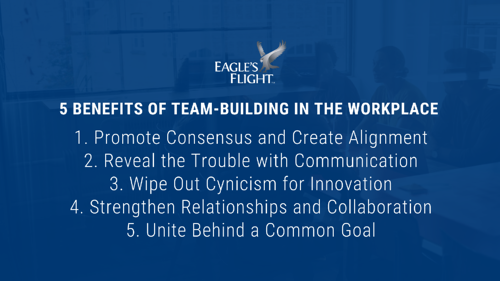Discussions about teamwork in the workplace often revolve around a few central topics: effective communication, sharing a common goal, and solving problems. While each of these are absolutely essential in strong teams, one key often seems to be missing – Leadership.
We think of teams as highly democratic entities where everyone contributes equally to complete a project. However, just like the Presidents and Prime Ministers that guide the world’s great democracies, a leader is essential to team success. In fact, the team at Eagle’s Flight considers leadership one of the seven cornerstones of teamwork. Without a clearly defined leader, the whole team foundation will crumble. Here’s why teamwork in the workplace must start with strong leadership:
1. Team Leaders Keep the Team Accountable
It’s far too easy to dodge responsibility in a team setting, since you can “hide” among your sea of colleagues. That’s where a leader comes in. In a team setting, a true team leader takes full responsibility for the team’s final results. Since a leader has so much on the line, he or she is extremely motivated to keep team members accountable for the work.
2. Team Leaders Empower Team Members
Being a leader on a team isn’t about concentrating power — it’s about giving away power. Yes, team leaders are responsible for assigning tasks to the team. Even more importantly, leaders must trust the skills and expertise of other team members. Through trust, leaders empower teams to carry out assigned tasks in the way that they see fit.
Why is trust so important? When other team members see that the leader has put his or her trust in a colleague, they won’t try to undermine or question that colleague. Plus, studies show that employee engagement is closely tied to the level of freedom and ownership that individuals are given. If you want team members to be engaged and excited about the project, leaders must empower members by easing up the reins.
3. Team Leaders Simplify and Streamline the Decision-making Process
Teams can avoid the power struggles commonly found in “equitable” teams with leaders in place. In these “equitable” or “leaderless” teams, members actually compete to gain authority and assert dominance.
Team leaders also make the decision-making process far more streamlined, since they have the final say. Leaderless teams may get stuck on making tough calls when members can’t come to a consensus and there’s no “tie-breaker” to turn to. In the meantime, the entire project — and even teamwork in the workplace overall — stalls. Having a clear-headed colleague who’s clearly in charge simply makes teams simpler.
4. Team Leaders Keep Projects Moving Forward
It’s hard to keep a group of people focused, so having someone make it their mission to do so is crucial to team success. A designated leader will move past any hiccups by initiating conversations about potential problems and steering the team back on track during meetings that start to go off the rails.
How do leaders keep projects moving forward? They will:
- Ensure all team members understand the project goal
- Establish clear deadlines
- Clearly define roles within the team
- Describe how each role contributes to the project goal
- Remind the team of the shared goal to keep the project on task
When members understand that the part they play on the team is critical to achieving the goal, they’re more motivated and engaged.
Team leaders are typically individuals who know the most about the project — which means they might not have extensive experience with leading. They might not even be the person with the most “senior” rank in the room. That’s why building in leadership skills exercises into your training on teamwork in the workplace is so important.







